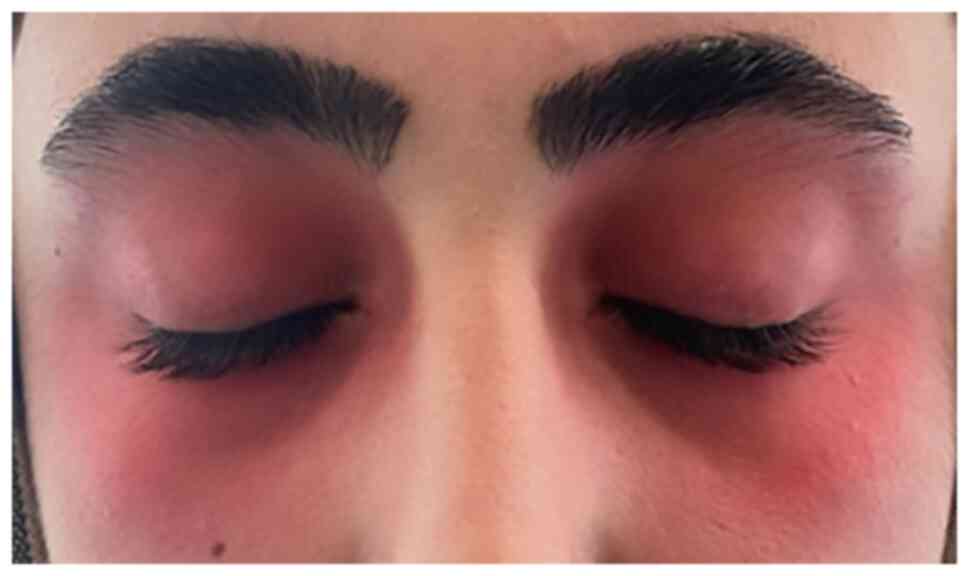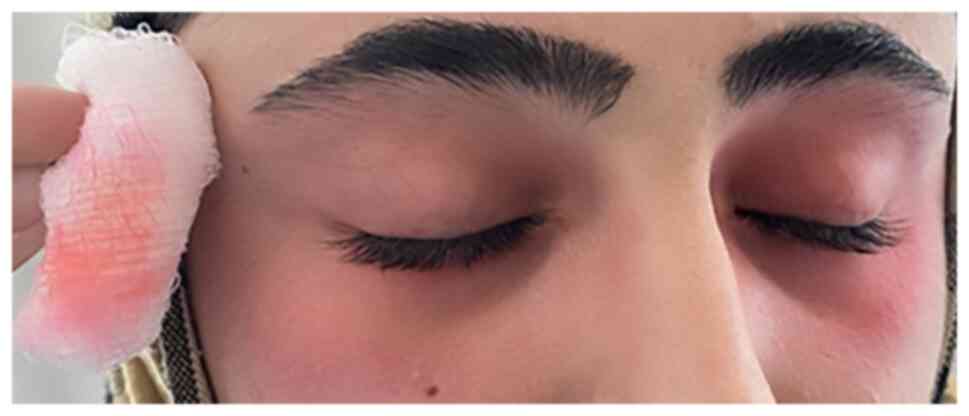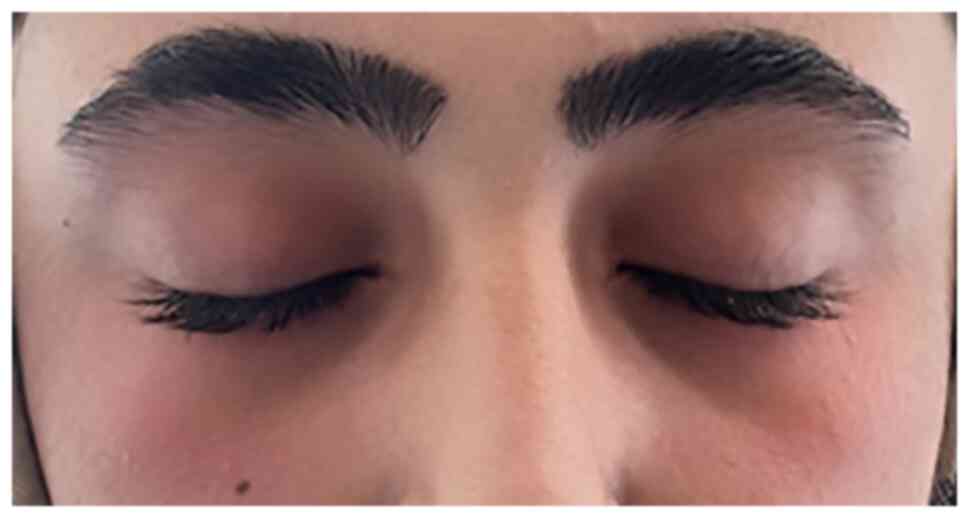Introduction
Dermatitis artefacta or factitious dermatitis is a
psychocutaneous disorder in which patients intentionally create
lesions on the skin, nails or mucosae for a psychological demand,
to attract attention, or to escape responsibility. It is known as
Munchausen syndrome if the patient tries to satisfy a psychological
demand by receiving medical attention (1,2).
These patients usually use sharp objects and irritating chemicals
to create lesions in the accessible area that exhibit symmetry and
irregular shapes, while the surrounding skin appears normal. The
lesions may mimic dermatological conditions and commonly appear as
redness, ulcers or gangrene. Subcutaneous emphysema or lymphedema,
secondary infections and septicemia can emerge as complications
(1,3). Dermatitis simulata is a condition in
which an individual creates apparent skin disease using an external
agent to simulate a known skin disorder. This behavior is often
associated with factitious disorder, which is characterized by a
psychological need for medical attention. Some external agents that
may induce temporary skin discoloration are cosmetics, crystallized
sugar and glue printing dyes, which can be easily cleared with
alcohol swabs (3).
Dermatitis artefacta is frequently not noticeable,
making it challenging to accurately determine its prevalence.
According to a previous study, which was conducted in Iran, found a
relative incidence of 6.7% among patients with psychodermatological
disorders (4). While this
condition can manifest at any age, it is more commonly observed in
early adulthood, following adolescence (5). Moreover, it tends to occur more
frequently among females, with reported female-to-male ratios
ranging from 2.8:1 to 20:1 in various studies (5,6).
Additionally, a higher prevalence is noted among females from lower
socioeconomic backgrounds (7). In
these conditions, it is necessary to conduct a detailed psychiatric
assessment to determine malingering when the patient has a hidden
motive to intentionally exaggerate or fabricate their symptoms for
personal advantage. Of note, malingering is not a medical term and
was not listed as a diagnosis in DSM-5(8). Malingering is distinguished from
factitious disorders through the deliberate presentation of
symptoms for personal benefits, such as financial gain or time off
work. By contrast, diagnosing factitious disorders necessitates the
absence of apparent rewards (1).
As a result of insufficient knowledge and the understanding of
psychocutaneous disorders among family physicians, internists and
other specialists, this may lead to misdiagnosis or delayed
diagnosis (3).
The present study reports a rare case of dermatitis
simulata in a young female. The references have been inspected for
reliability (9).
Case report
Patient information
An 18-year-old female patient presented to the Smart
Health Tower (Sulaimani, Iraq) with the recurrent overnight
appearance of red skin lesions around the eyes, which had persisted
for a duration of 6 months. She had visited numerous internists,
ophthalmologists and ENT specialists. The patient received several
topical and systemic treatments without any notable improvement. No
history of trauma or abuse were reported and there was no previous
history of any psychiatric disorders. In addition, there was no
history of any reported psychiatric disorder in her family members.
Apart from inquiring about the history of mental illnesses in her
family, no relevant genetic information could be elicited. The
client and her father declared that there were no any psychiatric
illnesses reported in the 1st and 2nd degree relatives.
Clinical findings
Upon a physical examination, the patient was found
to have a red skin lesion around the eyes with no associated
systemic manifestations, such as fever or pain.
Diagnostic assessment
A baseline laboratory investigation yielded normal
findings. Upon a dermatological examination, there were bilateral
symmetrical large pink-red glistening patches on the periorbital
skin, and other parts of the face were normal without similar
lesions elsewhere in the body (Fig.
1). Although the patient denied the use of cosmetics, the
exogenous color appeared to be a foundation (makeup), and it was
removed by cleaning the area around the eyes with gauze and 70%
alcohol; hence, a skin biopsy was not performed (Figs. 2 and 3).
Therapeutic intervention
The patient was referred for psychiatric evaluation
as part of the management, according to which the patient did not
have any extraordinary perceptual abnormalities. Structured
Clinical Interview for DSM (SCID) was employed, which is a
well-established diagnostic instrument within the mental health
field. The SCID serves as a structured interview guide,
facilitating the accurate and dependable diagnosis of psychiatric
disorders. Its criteria align with the Diagnostic and Statistical
Manual of Mental Disorders (DSM), rendering it a widely utilized
tool in the field. Based on the evaluation, the only identified
vulnerability factor in the tendency of this patient towards
factitious disorders are rooted in underlying psychological issues.
These issues include a craving for attention, a tendency to adopt
the ‘sick role’, and a desire to be perceived as a patient within
her extensive family. There were no signs of depression, although
the patient expressed some concerns that she will lose her eyesight
as no one could diagnose her condition (as several doctors had
examined her over the past 6 months). There were no apparent
motivations identified to encourage her misleading behavior. The
patient and her father, who met privately, denied any personal
advantages.
Follow-up
The patient was examined again after 2 months. There
was no presentation of any lesions around her eyes, according to
the examination of her skin and her parents, and no further
psychological stresses were reported. The importance of patient
education about her illness was clarified once again.
Discussion
Munchausen syndrome represents a chronic, severe
subtype of factitious disease in which an individual presents a
dramatic and untruthful story of illness (pathological lying)
(10,11). It is commonly prevalent among
females, individuals in early adulthood, people with underlying
psychiatric diagnoses, or people who have experienced external
stress. Healthcare professionals often witness this phenomenon, and
the common psychiatric findings linked to this condition include
borderline personality disorder, dependency and manipulative
behavior (12,13).
Patients with this condition commonly experience
neurological and abdominal complaints. The occurrence of
dermatological manifestations is rare, which may be created by
using sharp objects or chemicals that can mimic dermatological
diseases, such as erythematous and ulcerative lesions or
lymphedema. In rare cases, the initial presentation may involve
subcutaneous emphysema or lymphedema. Secondary infections and
septicemia can also arise from this lesion (1).
The main characteristic of these patients is a
recurrent illness with the same complaint and presentation, hence
visiting several specialties in different hospitals (1). Patients who have dermatitis simulata
usually use cosmetics to create skin discoloration, which can be
easily cleaned using alcohol swabs (14). The case presented herein exhibited
painless pink discolorations around the eyes; the lesions were
recurrent in the same anatomical distribution for a duration of 6
months. Psychocutaneous disorders are unfamiliar to other
specialists, such as family physicians and internists and usually
lead to a delay or missed diagnosis, as in the patient described
herein, who visited different internists, ophthalmologists and
otolaryngologists, yet received no definite diagnosis.
Additionally, these deceptions are sophisticated enough to mislead
and confuse doctors for months (3,15).
The approach of the authors to this case involved collaboration
between dermatologists, ophthalmologists and psychiatrists,
ensuring a comprehensive understanding of the condition of the
patient. This multidisciplinary approach allowed for a thorough
examination of both the dermatological and psychological aspects of
the case, contributing to a more holistic diagnosis and management
plan.
In line with the literature, the patient in the
present study was 18-year-old secondary school student diagnosed
with dermatitis simulata. Her skin lesions did not appear to be a
sign of any skin disease. In these cases, a psychiatrist monitors
and follows up on their psychological condition, and recommends
ongoing visits to the psychiatrist to provide psychotherapy
sessions. The sympathetic method of the psychiatrist and the
provision of a confidential environment can assist patients in
understanding their situation, which may lead to a change in their
deceptive behavior (1). The
approach to the case in the present study involved a collaboration
between dermatologists, ophthalmologists and psychiatrists,
ensuring a comprehensive understanding of the patient's condition.
This multidisciplinary approach allowed for a thorough examination
of both the dermatological and psychological aspects of the case,
contributing to a more holistic diagnosis and management plan. In
addition, the successful resolution of the symptoms of the patient
through the identification of the external cause (makeup) and
subsequent cleansing with alcohol highlights the effectiveness of
therapeutic intervention. Additionally, emphasis on patient
education, reassurance and ongoing care played a crucial role in
achieving positive outcomes, demonstrating a patient-centered
approach.
As regards treatment, factitious disorder treatment
imposed on self often involves a combination of psychotherapy and,
in some cases, pharmacotherapy. However, it should be noted that
individuals with this disorder can be challenging to treat, as they
may be resistant to acknowledging the underlying psychological
issues. Psychotherapy, including individual counseling, such as
cognitive-behavioral therapy or psychodynamic therapy, aims to
uncover and address the root causes that drive the individual's
need for attention through illness. Family therapy may also be
employed to explore familial dynamics and support systems. While
medications are not the primary treatment, they may be used to
address co-existing conditions, such as depression or anxiety,
under the management of a psychiatrist or mental health
professional. In severe cases, hospitalization may be necessary
when the actions of an individual pose a significant risk to their
health; however, this should be approached cautiously due to the
potential persistence of healthcare-seeking behaviors even in a
hospital setting. Building a therapeutic alliance is crucial, given
the difficulty individuals with factitious disorder may have in
acknowledging their psychological distress. Since treatment needs
to be individualized, a comprehensive assessment by mental health
professionals is essential to formulate an appropriate and
effective treatment plan (16). In
the case described herein, the client and her father declined
engagement in any of the therapeutic options mentioned above.
The primary limitation of the present study is its
reliance on a single case, which may limit the generalizability of
findings to a broader population. While the rarity of dermatitis
simulata poses challenges for obtaining a large sample, future
research with more cases could strengthen the external validity of
our observations.
Another limitation is that despite that psychiatric
evaluation, though essential, is inherently subjective, and
different evaluators may interpret findings differently.
Recognizing this subjectivity is crucial for understanding the
limitations of psychiatric assessments and emphasizing the need for
standardized protocols to enhance reliability in future cases.
In conclusion, Munchausen syndrome is a chronic and
severe factitious disease characterized by the fabrication of
dramatic and untruthful stories of illness. While neurological and
abdominal complaints are commonly reported, dermatological
manifestations are rare.
Acknowledgements
Not applicable.
Funding
Funding: No funding was received.
Availability of data and materials
The datasets used and/or analyzed during the current
study are available from the corresponding author on reasonable
request.
Authors' contributions
RSA was the main contributor to the conception of
the study. FHK was involved in the literature search and designed
the study. RSA and BAA participated in reviewing the literature, in
preparing and drafting the manuscript, and obtained medical images.
YNA, SOS, SMA, JIH, KFH, HSM and SFA critically revised the
manuscript, were involved in analyzing the patient's data and
advised on patient treatment. All authors contributed equally to
the manuscript, and have read and approved the final version of the
manuscript. FHK and BAA confirm the authenticity of all the raw
data.
Ethics approval and consent to
participate
Written informed consent was obtained from the
patient for her participation in the present study.
Patient consent for publication
Written informed consent was obtained from the
patient for the publication of the present case report and any
accompanying images.
Competing interests
The authors declare that they have no competing
interests.
References
|
1
|
Hariharasubramony A, Chankramath S and
Srinivasa S: Munchausen syndrome as dermatitis simulata. Indian J
Psycholo Med. 34:94–96. 2012.PubMed/NCBI View Article : Google Scholar
|
|
2
|
Pradhan S, Sirka CS, Dash G and Mohapatra
D: Dermatitis artefacta in a child: An interesting morphological
presentation. Indian Dermatol Online J. 10(72)2019.PubMed/NCBI View Article : Google Scholar
|
|
3
|
Hanumanthu V, Kamat D and Vinay K:
Dermatitis simulata: A curious case of photodistributed facial
rash. Indian Dermatol Online J. 13(138)2022.PubMed/NCBI View Article : Google Scholar
|
|
4
|
Ehsani AH, Toosi S, Mirshams Shahshahani
M, Arbabi M and Noormohammadpour P: Psycho-cutaneous disorders: An
epidemiologic study. J Eur Acad Dermatol Venereol. 23:945–947.
2009.PubMed/NCBI View Article : Google Scholar
|
|
5
|
Nielsen K, Jeppesen M, Simmelsgaard L,
Rasmussen M and Thestrup-Pedersen K: Self-inflicted skin diseases.
A retrospective analysis of 57 patients with dermatitis artefacta
seen in a dermatology department. Acta Derm Venereol. 85:512–515.
2005.PubMed/NCBI View Article : Google Scholar
|
|
6
|
Saez-de-Ocariz M, Orozco-Covarrubias L,
Mora-Magaña I, Duran-McKinster C, Tamayo-Sanchez L,
Gutierrez-Castrellon P and Ruiz-Maldonado R: Dermatitis artefacta
in pediatric patients: Experience at the national institute of
pediatrics. Pediatr Dermatol. 21:205–211. 2004.PubMed/NCBI View Article : Google Scholar
|
|
7
|
Pichardo AR and Bravo BG: Dermatitis
artefacta: A review. Actas Dermosifiliogr. 104:854–866.
2013.PubMed/NCBI View Article : Google Scholar
|
|
8
|
American Psychiatric Association DS,
American Psychiatric Association: Diagnostic and Statistical Manual
of Mental Disorders: DSM-5. American Psychiatric Association,
Washington, DC, 2013.
|
|
9
|
Muhialdeen AS, Ahmed JO, Baba HO, Abdullah
IY, Hassan HA, Najar KA, Mikael TM, Mustafa MQ, Mohammed DA, Omer
DA, et al: Kscien's List; A New Strategy to Discourage Predatory
Journals and Publishers (Second Version). Barw Med J: Mar 1, 2023
(Epub ahead of print).
|
|
10
|
Menninger KA: Polysurgery and polysurgical
addiction. Psychoanalytic Quarterly. 3:173–199. 1934.
|
|
11
|
Newmark N and Kay J: Pseudologia
fantastica and factitious disorder: Review of the literature and a
case report. Compr Psychiatry. 40:89–95. 1999.PubMed/NCBI View Article : Google Scholar
|
|
12
|
Lavery MJ, Stull C, McCaw I and Anolik RB:
Dermatitis artefacta. Clin Dermatol. 36:719–722. 2018.PubMed/NCBI View Article : Google Scholar
|
|
13
|
Abbas YN, Hussein DA, Abdullah F, Salih
RQ, Mohammed SH, Abdalla BA and Kakamad FH: Borderline personality
disorder; a psycho-analytic perspective. Barw Med J. 2023.
|
|
14
|
Burket JM and Burket BA: Factitial
dermatitis resulting in paraplegia. J Am Acad Dermatol. 17:306–307.
1987.PubMed/NCBI View Article : Google Scholar
|
|
15
|
Christopher E, Griffiths M, Barker J,
Bleiker TO, Chalmers R and Creamer D: Rook's Textbook of
Dermatology. Vol 4. 9th edition. Wiley-Blackwell, Hoboken,
2016.
|
|
16
|
Hendricks L, Smith D, Mitchell K, Hudson E
and Baig J: Factitious disorder among the African-American
Population. In: Changing the Stigma of Mental Health Among African
Americans: Moving from Denial to Acceptance, IGI Global, pp91-111,
2023.
|

















